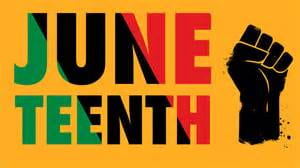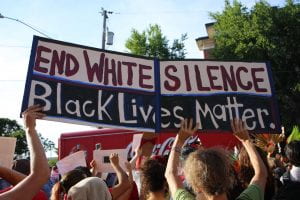by Endia Harris (student guest blogger)

“The people of Texas are informed that in accordance with a Proclamation from the Executive of the United States, all slaves are free. This involves an absolute equality of rights and rights of property between former masters and slaves, and the connection heretofore existing between them becomes that between employer and hired laborer.”
What is Juneteenth?
Celebrated on June 19th, Juneteenth commemorates the official end of slavery. Although President Lincoln signed the Emancipation Proclamation on January 1, 1863, the U.S. government made little effort to enforce the executive order, allowing Texas and other Southern states to uphold the institution of slavery for two and a half years after it was declared illegal. It was not until Union Major General Gordon Granger arrived in Galveston, Texas, on June 19, 1865, that the news of freedom and the end of the Civil War reached the enslaved people there. Alternatively called “Freedom Day,” “Emancipation Day,” and “Cel-Liberation Day,” African Americans have celebrated Juneteenth since the late 1800s.
History
In the decades following the ratification of the 13th Amendment, Juneteenth celebrations grew in size and popularity. Some formerly enslaved men and women and their descendants made pilgrimages back to Galveston to celebrate the holiday. Early celebrations often included a ritual in which revelers tossed ragged garments that enslaved people would have been forced to wear into the river and adorned themselves in fancy clothes taken from their former plantations. In 1872, a group of African-Americans ministers and businessmen purchased 10 acres of land in Houston and created Emancipation Park as a place to hold the city’s annual Juneteenth celebration. The festivities typically involved fishing, barbecue, rodeos, baseball, and prayer services.
In the early 1900s, Juneteenth celebrations declined, as White employers did not recognize the holiday and would not let Black people off work if the holiday fell during the work week. Educational text books for students marked the official end of slavery as January 1, 1863, without mentioning its continuance through the end of the war. American Independence Day was celebrated on July 4, and Juneteenth went largely under the radar. Celebrations were revived in the 1960s at the height of the Civil Rights Movement, and cities across the country reinstated the festivities. Through the tireless efforts of Al Edwards, an African-American state legislator, Texas declared Juneteenth a state holiday in 1980. Other states are following his lead. In fact, 45 states and the District of Columbia have either made Juneteenth a state holiday or an official day of observance; however, it is not yet a national holiday. This year, several corporations, including Target, Twitter, Nike, and the NFL have announced that June 19 will be a paid holiday for their employees.

The Struggle Continues
As we celebrate the official end of institutionalized slavery, it is important to remember that the struggle for true freedom and equality for African-Americans is far from over. As the country is waking up to the duel pandemics of COVID-19 and systemic racism, Juneteenth celebrations are expected to be particularly festive and well-attended this year. Following the deaths of George Floyd, Breonna Taylor, Ahmaud Arbery, Tony McDade, Rayshard Brooks and countless other victims of anti-Black violence, there is a renewed sense of urgency and activism around the Black Lives Matter movement. Massive protests are happening all over the country with hundreds of thousands of Americans demanding an end to systemic racism and police brutality. In order to truly understand and participate in Juneteenth celebrations, it is important to remember the horrors of slavery, the extreme violence inflicted on Black people in the years following liberation, and how these legacies continue to plague our society. In anticipation of Juneteenth, the Equal Justice Initiative has released a new report – Reconstruction in America – describing the various ways in which White people and the State invented new forms of slavery, perpetuated anti-Black sentiment and justified violence and oppression. As Bryan Stevenson aptly reminds us, “Slavery did not end in 1865, it just evolved.” Today, Black Americans still do not enjoy the same freedoms and rights as White people, as they continue to experience lynching, police brutality, mass incarceration, and unequal justice disproportionately to their White counterparts.
While Juneteenth in years past has focused on celebrating the advances that Black people have made in the United States, this year is expected to center around a call to action. For White people who want to show their support, this includes showing up for the causes of anti-racism and equal justice, understanding the structural and institutional underpinnings of white supremacy and white superiority, exploring their own complicity in upholding a racist social order, and using their privilege and agency to take actionable steps to dismantle racism, both in their personal lives and on an policy level.
History is calling the future from the streets of protest.
What choice will we make?
What world will we create?
What will we be?
There are only two choices: racist or anti-racist”
– Ibram X. Kendi
To learn more, watch Ibram X. Kendi’s inspiring TED talk.
